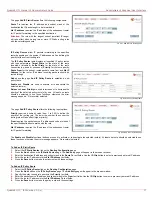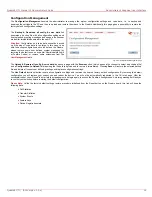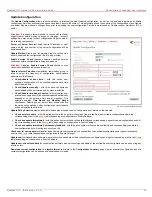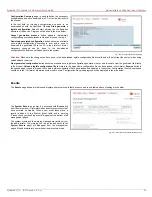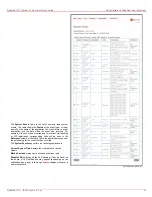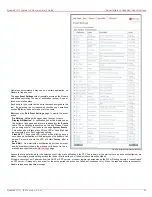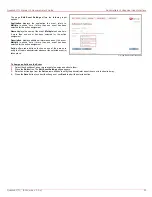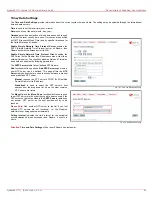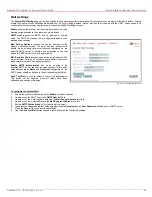
QuadroE1/T1 Manual II: Administrator's Guide
Administrator's Graphical User Interface
QuadroE1/T1; (SW Version 3.0.x)
16
SIP Registration Status
The SIP registration Status is a table displaying the SIP registration
status of the Quadro extensions. The table contains a list of all the
registered extensions of Quadro, information about SIP registration
states for them, addresses of SIP servers where they are registered (if
so), registration date and time, as well as SIP registration names. By
clicking on the row heading, the table will be sorted by the selected
column. Upon sorting (ascending or descending), arrows will be
displayed next to the column heading.
The links inside the table link you to the
208H
User Management
– Edit Entry
page where the extension’s SIP registration settings may be altered.
The Detected Connection Type field displays the connection type
Quadro currently is acting in (direct connection or behind NAT). If
Quadro is acting behind NAT, the NAT machine IP address is also
displayed.
Fig. II-18: SIP Registration Status page
H323 Registration Status
The SIP registration Status is a table displaying the H.323 registration
status of the Quadro extensions. The table contains a list of all the
registered extensions of Quadro, information about H.323 registration
states for them, addresses of H.323 gatekeepers where they are
registered (if so), registration date and time, as well as H.323
registration names. By clicking on the row heading, the table will be
sorted by the selected column. Upon sorting (ascending or descending),
arrows will be displayed next to the column heading.
The links inside the table link you to the
209H
User Management
– Edit Entry
page where the extension’s H.323 registration settings may be altered.
The Detected Connection Type field displays the connection type
Quadro currently is acting in (direct connection or behind NAT). If
Quadro is acting behind NAT, the NAT machine IP address is also
displayed.
Fig. II-19: H.323 Registration Status page
IP Routing Configuration
Routing is used to relay information across the Internet from a source to a destination. Along the way, at least one intermediate node is typically
encountered. Routing is often confused with bridging, which may seem to accomplish precisely the same thing to the casual observer.
Quadro’s IP Routing service allows to route IP packets from one destination to another (or to a specified router) through Quadro.
The IP Routing Configuration page is used to make IP Static and IP Policy routes for IP packets routing and has two tables.
IP Static Routes are used to forward IP packets from the
Network, where the Quadro is connected, to the specified
destination.
The IP Static Routes table displays all established IP static
routes with their parameters: Target State for the state of the
route (enabled or disabled), Actual State for the state of the route
connection (up, down or erroneous), Route To for the subnet
where the incoming packets should be routed and Via IP Address
for the router IP address incoming packets should be routed
through.
Add opens the Add IP Static Route page where a new static
route can be established.
Enable/Disable are used to activate/deactivate selected route(s).
At least one route should be selected in order to use these
functions, otherwise the error message appears: “No record(s)
selected.”
Fig. II-20: IP Static Routing table
















